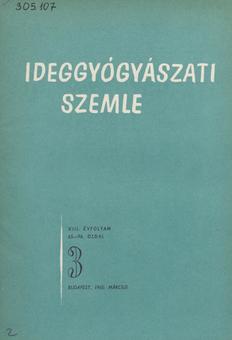The eLitMed.hu medical portal uses computer cookies for convenient operation. Detailed information can be found in the Cookie-policy.
Clinical Neuroscience - 1960;13(03)
Content
[LSD studies in schizophrenic patients treated with electroshock ]
[1. Based on a comparison of the symptoms of eight schizophrenic patients with ES block before and after treatment with 50- 125 gamma LSD, the change in response after treatment was analysed from a pathophysiological and localisation point of view. 2. ES block treatment did not completely prevent the development of LSD intoxication symptoms, but the reactio was strikingly poor. No activating effect was observed. 3. Symptoms partially corresponded to specific LSD symptoms. No cortex localisable intoxication symptoms developed. 4. Subcortical and midbrain symptoms were present. Brainstem movement disturbances and neurovegetative changes were suggestive of diencephalic dysregulation.]
[Data for the biography of Ferenc Schwartzer]
[The author presents a detailed description of Ferenc Schwartzer, found in the Hungarian National Archives, written by Adolf Hollán, the counsellor of the Interior Ministry, in his own handwritten submission for the award of the medal on 27 October 1871.]
[Intravascular use of Novocaine in epilepsy]
[Based on his observation of 30 epileptic patients, the author found intravascular N. given in combination with standard antiepileptic drugs to be therapeutically effective in the majority of cases in the treatment of affective and mood disorders, and in the elimination of foggy states of consciousness. The anticonvulsant action of N. was pronounced in the resolution of both sporadic and status seizures. The improvement was confirmed by EEG studies along with clinical symptoms. Based on the literature on the pathomechanism of epileptic disease symptoms and his own clinical and EEG observations, he attempts to explain the complex effect of N. He considers its use to be justified mainly in cases where conventional treatments have not led to satisfactory results. ]
[Effect of strophanthin on blood flow to the brain, potassium and sodium balance, and cerebral venous pressure]
[The effects of strophanthin on cerebral circulation and brain potassium and sodium balance were studied in circulatory healthy people. The blood flow through the brain increases with acute strophanthin, while the resistance of cerebral blood vessels decreases. Cerebral venous pressure is also markedly reduced. The brain releases potassium in response to Strophanthin. It is considered likely that strophanthin has a significant brain attack point. Alteration of the brain's potassium balance is a major cause of the central effect of strophanthin.]
[Effect of Andaxin ( meprobamate) on skeletal muscle phosphorylase activity]
[1. The effect of Andaxin (meprobamate) on skeletal muscle phosphorylase activity of dogs, rats, rabbits and guinea pigs after 4-6 days of enteral meprobamate administration was investigated. 2. Our results show that after Andaxin treatment, the phosphorylase activity of dog muscle decreased by 25-73% (45% on average) and that of rat muscle by 19-56% (40%). 3. Rabbit muscle phosphorylase activity increased by -9.3 -( +170.0)% (43%) and guinea pig by 114% after Andaxin administration. 4. The phosphorylase activity of skeletal muscle of dog, rat, rabbit, guinea pig was not affected by Andaxin in vitro.]
[Comment on the article "The problem of remuneration for occupationally mentally ill people"]
[The development of specific operating rules for institutions for the treatment of the mentally ill, different from those for hospitals, in line with their specific situation, and taking into account the following aspects: 1. in the case of rehabilitation institutions, economic profitability, with appropriate deductions for the remuneration of patients. 2. in the case of a therapeutic establishment, the therapeutic aspect, with the possibility of rewarding the patient in various ways for psychotherapeutic purposes and, at the same time, with appropriate social care. 3. formation of a joint committee of appropriate financial and mental health professionals to clarify various financial issues.]
1.
Clinical Neuroscience
[Headache registry in Szeged: Experiences regarding to migraine patients]2.
Clinical Neuroscience
[The new target population of stroke awareness campaign: Kindergarten students ]3.
Clinical Neuroscience
Is there any difference in mortality rates of atrial fibrillation detected before or after ischemic stroke?4.
Clinical Neuroscience
Factors influencing the level of stigma in Parkinson’s disease in western Turkey5.
Clinical Neuroscience
[The effects of demographic and clinical factors on the severity of poststroke aphasia]1.
2.
3.
4.
5.



